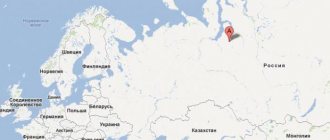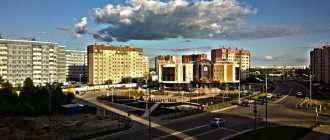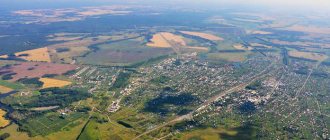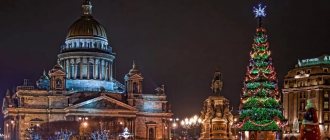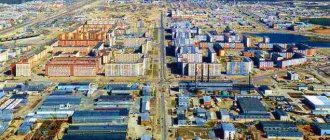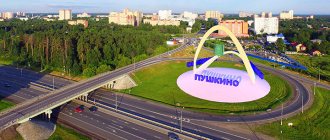The memorable date is full of various events. An entertainment program is organized on this day. Folklore groups perform folk songs. Circus troupes demonstrate magic tricks and acrobatic acts. The brass band plays famous compositions.
Agricultural exhibitions are organized where producers present and sell their products. Museums display exhibits related to the history of the locality. Sports competitions in football and martial arts are held. Administration representatives reward the winners. In the evening, invited pop stars appear on stage. The holiday ends with volleys of fireworks.
Pushkino City Day is celebrated on the last Saturday of August. In 2021, ceremonial events are held on August 28.
City information
Pushkino is the administrative center of the district of the same name in the Moscow region. Located in the west of the Russian Federation. The economy is represented by enterprises of engineering, food, manufacturing, and light industries.
Near the settlement there are federal and territorial highways: M8 Kholmogory, MKAD. There is a railway connection. There are universities and their branches, professional and secondary specialized educational institutions. Cultural institutions are functioning. There are attractions related to history and architecture.
Notes
- ↑ 12345
Moscow region Municipal districts Volokolamsky • Voskresensky • Dmitrovsky • Egoryevsky • Zaraisky • Istra • Kashirsky • Klinsky • Kolomensky • Krasnogorsky • Leninsky • Lotoshinsky • Lukhovitsky • Lyuberetsky • Mozhaysky • Mytishchi • Naro-Fominsky • Noginsky • Odintsovo • Ozersky • Orekhovo-Zuevsky • Pavlovo-Posad • Podolsky • Pushkinsky • Ramensky • Ruzsky • Sergiev Posad • Serebryano-Prudsky • Serpukhovsky • Solnechnogorsky • Stupinsky • Taldomsky • Chekhovsky • Shatursky • Shakhovskoy • Shchelkovsky Urban settlements Andreevka • Aprelevka • Ashukino • Beloozersky • Beloomut • Bogorodskoye • Bolshiye Vyazemy • Bolshiye Dvory • Bykovo • Verbilki • Vereya • Vidnoe • Volokolamsk • Voskresensk • Vysokovsk • Golitsyno • Leninskie Gorki • Dedenevo • Dedovsk • Dmitrov • Drezna • Egoryevsk • Zhilevo • Zagoryansky • Zaprudnya • Zaraysk • Zarechye • Zelenogradsky • Iksha • Ilyinsky • named after. Vorovsky • named after. Tsyurupy • Istra • Kalininets • Kashira • Klin • Kokoshkino • Kraskovo • Krasnogorsk • Krasnozavodsk • Kratovo • Kubinka • Kurovskoe • |Lesnoy • Lesnoy Gorodok • Likino-Dulyovo • Lotoshino • Lukhovitsy • Lvovsky • Lyubertsy • Malakhovka • Malino • Mendeleevo • Mikhnevo • Misheronsky • Mozhaisk • Monino • Moskovsky • Mytishchi • Naro-Fominsk • Nakhabino • Nekrasovsky • Novoivanovskoye • Noginsk • Obolensk • Obukhovo • Odintsovo • Ozherelye • Lakes • Oktyabrsky • Pavlovsky Posad • Peresvet • Sands • Pirogovsky • Povarovo • Pravdinsky • Proletarsky • Pushkino • Ramenskoye • Reshetnikovo • Rzhavki • Springs • Ruza • Ryazanovsky • Sverdlovsky • Northern • Selyatino • Sergiev Posad • Serebryanye Prudy • Skoropuskovsky • Bullfinches • Solnechnogorsk • Sofrino • Staraya Kupavna • Stolbovaya • Stupino • Sychevo • Taldom • Tomilino • Tuchkovo • Uvarovka • Udelnaya • Fryanovo • Khorlovo • Khotkovo • Cherkizovo • Cherusti • Chekhov • Shatura • Shakhovskaya • Shchelkovo • Elektrougli • Yakhroma Coats of arms of rural settlements of the Moscow region
Story
The history of Pushkino begins in the second half of the 14th century. The name of the settlement comes from the surname of the owner of the area. Soon the village began to belong to the patriarchs. Its development was facilitated by its location on an important trade route in North-Eastern Rus'. In the 18th century, the production of fabrics and products made from them appeared there. In the second half of the 19th century, country houses were located here.
Soon the territory began to gain popularity among wealthy people. Infrastructure facilities, educational institutions, post office, and telegraph were launched. Large textile factories operated.
On August 17, 1925, the village of Pushkino acquired the status of a city. In 1953, it was classified as a settlement of regional subordination. During this period, rapid construction was carried out in it, new microdistricts arose.
At the beginning of the 21st century, it was expanded by including a number of villages. Close business ties have been established with Moscow.
So, a trip to Konstantinovo. I immediately apologize for the quality of the photos. I'm not a photographer, and my equipment is purely amateur. I just wanted to share my impressions. Early Sunday morning on June 16th of this year, 2013, we left home. We got to Ryazan in a breeze on a comfortable bus from Vykhino in less than 3 hours. We stayed at the Priokskaya Hotel. While we were riding on the bus to the hotel, the residents of Ryazan gave us advice on where to see things - what nice people! Grandfather talked about the underground passage on the territory of the Kremlin, remembered the times when boats flew to Konstantinovo, an aunt immediately joined in and talked about the airborne school, another aunt promised to indicate the right stop - in general, Ryazan welcomed us with open arms. We dropped off our things at the hotel and immediately headed to Sergei Alexandrovich’s native village. It turned out that getting to it from Ryazan is much more difficult than from Moscow to Ryazan. Buses go there only in the morning and in the evening - we, accordingly, did not have time for the before lunch, and it was not our plan to wait for the evening one. We decided to go to Rybnoye, from there it’s another 20 km to the village, but we thought maybe it would be easier with transport there. But no! While we were traveling in the bus, another kind Ryazan resident suggested that there are no buses from Rybnoye to Konstantinovo, and it would be better for us to get off “at the cross”, and there it is 5 km, and here it is - the gentle homeland. There is hope of catching a ride. We leave “at the cross.” “Hitchhikers” there rush at a minimum of 120 km/h and do not think about taking fellow travelers. We are doomed to walk 5 km. But nothing can stop true fans. And what a beauty! The road is in an open field, and there are no houses on the horizon. “Only blue sucks eyes” We wandered and wandered, having lost faith in kind-hearted car enthusiasts, resigning ourselves to the lot of meek travelers, and finally arrived.
We were greeted by a village with domestic cattle grazing wildly.
And here it is! Favorite region! The heart dreams of stacks of sun in the waters of the bosom. I would like to get lost in the greenery of your hundred-bellied greens. Along the border, on the edge, there is mignonette and a riza of porridge. And the meek nuns call Willow to the rosary. The swamp smokes like a cloud, Burnt smoke in the heavenly rocker. With a quiet secret for someone I hid thoughts in my heart. I meet everything, I accept everything, I am glad and happy to take out my soul. I came to this earth to leave it quickly.
Behind the mountains, behind the yellow valleys, a trail of villages stretches. I see a forest and an evening fire, And a hedge entwined with nettles. There, in the morning, over the church domes, the heavenly sand turns blue, and the roadside grasses ring from the lakes with a watery breeze. It is not for the songs of spring over the plain that the green expanse is dear to me - I fell in love with the melancholy of a crane On a high mountain a monastery. Every evening, as the blue clouds over, as the dawn hangs on the bridge, you go, my poor wanderer, to bow to love and the cross. The meek spirit of a monastery resident, You eagerly listen to the litany, Pray before the face of the Savior for my lost soul.
The terrain there is hilly, waist-deep grass. The hike along the Oka River was a good addition to our 5-kilometer run. Plus, the weather had cleared up, the sun was baking the tops of our heads, and the midges, which were there in abundance, were terribly happy about our appearance. But this is such nonsense compared to what we are lucky enough to breathe deeply and absorb with our eyes
life and death…
This street is familiar to me, And this low house is familiar. The wires of blue straw fell over the window. There were years of severe disasters, Years of violent, insane forces. I remembered my village childhood, I remembered the village blue. I did not seek either glory or peace, I am familiar with the vanity of this glory. And now, when I close my eyes, I see only my parents’ house. I see a garden dotted with blue, August quietly lay down against the fence. The linden trees are held in their green paws. Bird noise and chirping. I loved this wooden house, A menacing wrinkle glowed in the logs, Our stove howled somehow wildly and strangely on a rainy night. The voice is loud and sobbing, like talking about someone dead, alive. What did he see, a brick camel, in the howling of the rain? Apparently, he saw distant countries, The dream of another and blooming time, The golden sands of Afghanistan And the glass gloom of Bukhara. Oh, and I know these countries - I myself have walked a long way there. Only closer to my native land I would like to turn now. But that gentle slumber faded away, Everything decayed in blue smoke. Peace be with you - the straw of the field, Peace be with you - a wooden house!
View from the Yeseninsky yard
Sergun planted poplar
Neighbors of the Yesenins (residential house)
Zemstvo primary school, where little Seryozhka studied
The Kashins' estate
Well, the village, of course, is far from being in the form in which Sergun loved it: ideal lawns, tiled paths, restored buildings, exhibits covered with yellow ribbons - a tourist complex. Yesenin is alive on the banks of the Oka, in the present village his presence is faintly felt. After dinner at a restaurant around 8 pm, we set off for Ryazan. The last bus leaves from Konstantinovo to Ryazan at 20:00. We hoped that it would not be cancelled, however, when a taxi kindly stopped in front of us, offering to take us to the hotel entrance for 700 re, we could not refuse, remembering our heroic forced march. Moreover, the price for 40 km is frankly trivial. Crushed in room a bottle of cognac for the blessed memory of our Sergei Alexandrovich, we fell asleep closer to midnight. I slept great! The air of Ryazan is, indeed, somehow healing. We had breakfast and went for a walk around the city. On the morning of June 17 it’s +28, the sun is blazing hot! territory of the Ryazan Kremlin:
A little bit of Ryazan
Tame birds
and foot
get in line, you sons of bitches, get in line!
On June 17 at about 9 pm we are already in Pushkino. Wow, it turns out it’s so cold and rainy here!
Coat of arms
The coat of arms of Pushkino is presented in the form of a French shield. On a green background, purple canopies (curtains) with gold fringe are shown hanging on both sides. They are held up by strings with gold tassels extending from the edge of the shield. In the center there is a golden upper tier of a bell tower with a church dome, completed with a four-pointed cross patterned at the ends, and with one visible arch filled with azure.
The artistic composition was adopted by the decision of the Council of Deputies of the urban settlement of Pushkino, Pushkin municipal district, Moscow region dated June 24, 2010 No. 94/10/2.
Deputies approved the new coat of arms of the city of Pushkin. How do you like it?
On July 2, an extraordinary meeting of the Council of Deputies of the united district was held. Among the 16 issues on the agenda that are important and really require consideration as quickly as possible, there was an issue on which the decision made excited the public and caused a storm of not the most flattering comments from social networks and instant messengers
.
We are talking about the approval of the Regulations on the official symbols (coat of arms and flag) of the Pushkinsky Urban District of the Moscow Region.
Let me remind you that relatively recently, at one of the meetings, deputies voted for the temporary use of the symbols of the coat of arms and flag of the Pushkin urban district as official for the newly formed district. Let me remind you that they were inherited from us without changes from the Pushkin municipal district.
Yes, it was time to change them. The sable and bobbin depicted on the coat of arms have long ceased to be the pride and symbols of our municipality. The number of black sable miraculously preserved and surviving in the early 2000s at the Animal Farm is slowly declining, the enterprise is in debt and is preparing to go into private hands. And the former glory of weaving industries has completely faded away, and only recently came back to life when one of them began producing protective masks.
But the appearance of new symbols of the united municipality came as a surprise to the absolute majority of the district. "It's a joke?" — this is how social media users reacted to the message about the adoption of the coat of arms. By the way, for those who haven't seen it yet, here it is:
How was the unexpected appearance of new symbols of the municipality perceived in the local community, what are they associated with? I will publish the most decent and correct statements of experts from the chat of our portal on WhatsApp (representatives of our administration and the government of the Moscow region are present there, they can read the rest of the comments on their own and draw conclusions. An appeal to them in the chat has already been posted: “Why didn’t the new government take an interest in the opinion of the people about the coat of arms. It was possible to make a discussion on social networks. It’s not good to do this, not giving a damn about the opinion of the people..." Comments are promised):
I'm sitting behind bars, I'm a young lion. Burn with blue flame the entire native district.
Was there really no specialist in the district who could reflect our district? Can you give me the name of the author of this drawing?
Why the lion? We don't live in Africa. And it seems like we are not involved in their breeding and distribution in the Pushkin District.
The coat of arms lasts for decades. It doesn’t matter how many heads have changed, but the district’s coat of arms was there for many years and suited everyone. Now what?
Maybe we can organize a petition from the people?
United Russia presented a gift to the residents of District 13 for the elections on September 19. And nothing else!
Yeah. Many of my friends will vote for the Communist Party of the Russian Federation and the Liberal Democratic Party. They said that this batch was over. Looking at the coat of arms, I understand why. That's it, we've arrived.
I’m honestly shocked, I can’t imagine how this can be approved as a symbol of the district. King of diamonds with a cannon in his mouth...
Yesterday they disgraced deputies in groups until 2 am. Now it will rain from letters to the Presidential Administration. So I’m thinking, why should the social situation heat up before the elections? Who benefits?
Let the deputies admit their decision is erroneous and go around as before the elections and offer options to the people. Let's vote.
I think that the indignation of the people will reach the head and he will make the right decision.
I wonder, shouldn’t it have been agreed with the residents?
And this last question of Bakha Khasanov is perhaps the most important.
Even when they were going to install steles at the entrances to the Pushkinsky district, the then administration announced a competition, held a vote, and all local media, including our portal, published the proposed options. Yes, it didn’t work out, they didn’t find the money to install them, but the main thing is the right approach, which evokes respect for the organizers. If we look at our other publications, we will see many cases where authorities turned to residents for advice and opinion, making relatively significant changes in our lives. It would be nice for the current authorities and deputies to remember this practice and not make single-handed decisions that ultimately cause such violent indignation among residents. By the way, not all deputies liked the symbols. The decision was made by 13 votes with 7 against (Nekrasova, Privalova, Andreev, Borzykh, Savenko, Potekhin, Ryzhakin). Another 10 deputies were not present at the meeting. I do not rule out that some of them did not come to the Council because their internal convictions did not allow them to vote for such a coat of arms, and internal party discipline did not allow them to vote against it.
And deputy from Ivanteevka Vladimir Savenko, having worked with local entrepreneurs (Vladimir Andreevich has headed the Council of Entrepreneurs of Ivanteevka since 1996) on the issue, even proposed his own versions of the coat of arms of the city of Pushkin. How do you like it? I like the one in the middle:
As they correctly write on social networks, it would be nice to find out (and publish, we are ready to provide pages of our portal for this) the opinion of local historians, headed by Vasily Vasilyevich Panchenkov. Who else but they should become the main experts, together with heraldists, in creating the main symbols of the municipality.
What would you suggest to depict on an alternative version of the city’s coat of arms? Pushkinsky? What do you associate your small Motherland with, what are you ready to be proud of when looking at the municipality’s flag? Leave your comments under this article and in the portal’s public pages on social networks, let’s hope the time will come when the deputies will hear the opinions of residents and take them into account.
To understand the attitude of residents towards the new symbols of the municipality, a vote has been organized in the public portal of the portal, leave your opinion:
Deputy Andrey Andreev is going to file a lawsuit against this decision of the Council. He needs a petition from the population. He appealed to public opinion leaders to collect signatures in his support and the process has already begun. Things like the heraldic symbols of the municipality should unite residents, evoke a sense of pride and respect. So far, unfortunately, the opposite is happening...
I will conclude the material with a sarcastic comment from one of the residents: “I know an excellent version of the coat of arms for our district. This is exactly for us - Malevich’s black square.” I hope that not everything is so hopeless and that the authorities will listen to the opinions of the residents.
Alexander Nozdrovsky
PS The post, which explains the decision made by the deputies, was posted in his public page by the head of the city of Pushkinsky, Maxim Krasnotsvetov
(I am pleased with his prompt response to the reaction of residents)
:
Dear friends, in connection with the approval of the symbols of the Pushkinsky City District, residents are receiving many fair questions. I would like to note, first of all, that the heraldic symbols of the cities of Pushkino, Ivanteevka and Krasnoarmeysk are preserved. It is allowed to use the image of the coats of arms of these cities when designing various cultural events, sporting competitions, etc.
A new city district cannot exist without a new coat of arms and flag. The symbolism was created by a member of the Board of the Union of Heraldists of Russia Kirill Perekhodenko @kir_perekhodenko.
The main question is: “What does symbolism mean”?
— Three diamonds are the three cities that made up the new municipality - Pushkino, Ivanteevka and Krasnoarmeysk; — Green color is a symbol of nature, health, youth; — A lion’s (leopard) head holding a gun barrel allegorically symbolizes the historical connection with artillery troops. The image of a lion's head with a barrel in its mouth was common as a decoration for the protective armor of artillerymen - breast mirrors. There are several versions of the origin of the name Pushkino, but the most historically justified is related to the fact that the Cannon Yard and the Pushkar settlement were located here. The history of the 20th century is also connected with artillery; — Tongues of flame complement the symbolism of the gunners. Also, flame is a symbol of spiritual fire, combustion allegorically indicates a special role in the formation and development of local lands; — Two small diamonds (spindles) indicate the numerous textile enterprises; — Through the rhombus - also a heraldic designation of weaving spindles indicates the abundance of linen, cloth, dyeing workshops and factories, which became the basis of industrial production in the Pushkin lands.
Let me emphasize once again - each city retains its heraldic symbols, the new coat of arms is used for the united Pushkinsky Urban District.
I thank the residents for their concern and active position.
PPS Just in case, I’ll post a description and rationale for the symbols that was presented to the deputies, maybe it will somehow clarify:
2. Heraldic description and rationale for the symbolism of the coat of arms of the Pushkinsky Urban District
2.1. The heraldic description of the coat of arms of the City District reads:
“In a green field there is a silver spindle (through rhombus), accompanied inside by a golden leopard head, holding in its mouth a black gun barrel with the muzzle to the left, and in the corners alternately two golden flames and two small spindles of the same metal.”
2.2. Justification of the symbolism of the coat of arms of the Pushkinsky Urban District.
The coat of arms, in the language of symbols and allegories, reflects the historical and cultural features of the Pushkinsky Urban District.
The modern Pushkinsky Urban District includes the territories of three urban districts - Ivanteevka, Krasnoarmeysk and Pushkinsky Urban District. The history of these lands near Moscow goes back more than one century and was largely common.
The through rhombus - the heraldic designation of weaving spindles indicates the abundance of linen, cloth, dyeing workshops and factories, which became the basis of industrial production in the Pushkin lands and glorified them.
The symbolism of the three end-to-end rhombuses in the coat of arms - a large one and two small ones - is multi-valued. Heraldic device - repetition of a figure enhances its symbolism. Three diamonds show a special role in the economic development of all cities that are part of the new municipality.
The three diamonds are also the three cities that made up the new municipality - Pushkino, Ivanteevka and Krasnoarmeysk.
On the other hand, several diamonds emphasize the diversity of production in the textile and paper industries, which is most clearly visible on the territory of Ivanteevka, where sailing, paper and wallpaper factories operated. The white color of one of the diamonds also indicates paper production.
The lion's (leopard) head holding a gun barrel allegorically symbolizes the historical connection with artillery troops. The image of a lion's head with a barrel in its mouth was common as a decoration for the protective armor of artillerymen - breast mirrors.
There are several versions of the origin of the name Pushkino, but the most historically justified is related to the fact that the Cannon Yard and the Pushkar settlement were located here. The history of the 20th century is also connected with artillery. It was here at the Sofrinsky artillery range, 5 days before the start of the Great Patriotic War, that demonstration firing of the first Soviet rocket artillery combat vehicle “BM-13”, which soon received the name “Katyusha”, was carried out.
The symbolism of flames in the coat of arms is ambiguous:
tongues of flame complement the symbolism of the gunners who gave the city its name;
tongues of flame as a symbol of spiritual fire, combustion allegorically indicates the special role of the Russian Orthodox Church in the formation and development of local lands, both economic and cultural.
The first known owners of these territories were Ivan Kalita’s associate, Metropolitan Peter, and then Metropolitan Alexei, one of the most prominent statesmen of the 14th century. And subsequently, nearby monasteries and temples often played a special role in the life of the population.
flames are also an image of creative fire, creative search - it is known that it was in Pushkino, in the summer theater created here, that the foundations of that theatrical art were laid, which subsequently led to the founding of the Moscow Public Art Theater (MKhT, since 1920 MKhAT). It was here, in Pushkino, at the turn of the 19th-20th centuries, that K. S. Stanislavsky and V. I. Nemirovich-Danchenko lived and worked.
The colors used complement the symbolism of the coat of arms:
Green color is a symbol of nature, health, youth, growth in life; it shows the location of the Pushkino Urban District among forests.
Gold means: wealth, stability, justice, mercy.
Silver signifies purity, perfection and nobility.
Black color is a symbol of wisdom, knowledge, modesty.
Symbolism
“The Pushkinogorsk land is known and has been part of the history and culture of our country for several centuries. The modern village of Pushkinskie Gory, formerly called the Holy Mountains, grew up around the Svyatogorsk Monastery, founded in 1569 by decree of Ivan the Terrible. The monastery, a fortress that protected the approaches to the city of Voronin, was already considered one of the most famous and richest Russian monasteries in the 17th century. The Voronich settlement is a man-made fortification that was created on the banks of the Soroti River in the 14th century on the border with the Grand Duchy of Lithuania and Livonia.
The nearby Savkina Hill has been known since the beginning of the 16th century, when a stone cross was erected on it in memory of fallen Russian soldiers.
The three golden mountains in the coat of arms reflect three historical mountains: Savkina Hill, the Voronich settlement and the Pushkin Mountains (previously called the Holy Mountains and Sinichy). The shape of the central mountain in the form of a dome emphasizes the high cultural and historical significance of the Svyatogorsk Monastery.
The ancestors of Alexander Sergeevich settled on this land in 1742 - Empress Elizaveta Petrovna granted Mikhailovskaya Bay to Abram Petrovich Hannibal. Over time, Mikhailovskoye became the family estate of the Hannibal-Pushkins.
The time spent by Alexander Sergeevich Pushkin in the family nest greatly affected the poet’s work; this was largely facilitated by the Pushkinogorsk nature, the opportunity to communicate with people of different classes, and observe people’s life. It’s not for nothing that the poet wrote about these places:
“Greetings, deserted corner,
A haven of peace, work and inspiration..."
Imbued with love for this region, Alexander Sergeevich bequeathed to bury himself here in the Hannibal-Pushkin family cemetery.
- The winged horse is a symbol of creative, poetic inspiration, flight, and spiritual quest. In the coat of arms, it symbolizes the connection of the urban settlement with the life of the great poet, whose name became part of the name of the municipality.
- The gold color in heraldry is a symbol of wealth, stability, respect, and intelligence.
- Silver color in heraldry is a symbol of purity, perfection, peace and mutual understanding.
- The color blue in heraldry is a symbol of honor, nobility, and lofty aspirations.”
